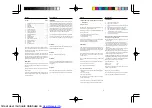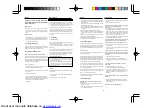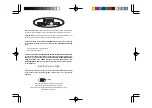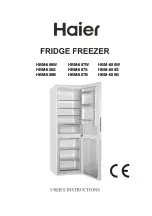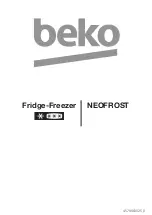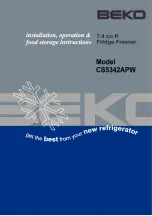
Great user manuals database on
!"#
English
8. Making ice cubes, ice cream and water ice
(not available in some models, only for freezer
with 4 star marking).
Making ice cubes:
●
Add water to ice tray to 3/4 of its volume, place it at the bottom
area of the freezer. When ice cubes are ready, flush the ice
tray with running water, then, you can easily take out the ice
cubes.
Making ice cream:
●
Remove separators of the ice tray. Please note the creamier
your ice cream is, the longer it will take to make it. When ice
cream is ready, flush the ice tray with running water, then, you
can easily take out the ice cream.
9. Preparing for Vacation
For long vacation or absence, unplug the freezer and clean the
freezer as described in “Cleaning and Maintenance”. Leave the
doors open to prevent formation of mildew or odor.
10. Cleaning and Maintenance
Unplug or disconnect the appliance before cleaning.
Keep the outside clean. Use furniture polisher or finishing condi-
tioner to clean the outside regularly (do not use these cleaners
to clean the inside).Wipe the door gasket with a cloth lightly dam-
aged with lukewarm water. No detergent is allowed. Never use
oil or grease to clean the door gasket.
Clean the inside regularly
●
Clean the freezer compartment on a monthly basis and clean
the freezer compartment after a defrost cycle.
●
Take out foods from freezer compartment and keep those foods
in a cool place.
●
Remove all detachable parts.
●
Interior parts are not suitable to be washed in a dishwasher.
Wash them manually using lukewarm water and some dish
detergent. Do not use concentrated detergent, abrasive agents
and chemicals such as acids. Mild dish detergent is
recommended.
Steam cleaners and dangerous and strictly prohibited.
Wash the inner compartment with lukewarm clean water and dry
with a soft cloth. It is absolutely dry after waiting for 3-4 minutes.
Do not destroy or remove the rating plate of the freezer. It could
be needed for after-sales service or relevant processes.
Make sure water doesn’t get into electric parts in the freezer.
If a heat exchanger (condenser) is mounted on the back of
freezer, dust and lint should be removed regularly to enable effi-
cient heat dissipation and avoid excessive power consumption.
Use a soft brush or a duster to clean the outside of heat
exchanger.
11. Defrosting
Freezer compartment
The freezer compartment, intended for storage of frozen food,
doesn’t have automatic defrosting.
The freezer compartment should be defrosted regularly. Defrost
the freezer compartment whenever the thickness of ice layer
reaches 5cm.
Unplug the freezer before defrosting. Take out foods from the
freezer compartment and kept these foods in a cool place. Use
an ice scraper to remove the ice. To speed up the process, place
a bowl of hot water in the freezer compartment. Clean and re-
load the freezer compartment after defrosting.
POTENTIAL SAFETY HAZARD!
Don’t use electrical devices such as hair dryer, electrical fan,
steam cleaner, defrost spray or open fire (such as candle) to
defrost the freezer compartment.
The plastic parts of inner compartment may get melted and any
spark or open fire may cause fire in presence of explosive gas.
Never use a steam cleaner to defrost the freezer compartment-
danger of electric shock!)
Cautions!
Take out the drawer, and wrap up the frozen foods with newspa-
per or blanket.
●
Keep these foods in a cool place before the defrosting pro
cess is finished.
●
Keep the door of freezer compartment open.
English
●
Ice and frost form on the surface of evaporator during operation.
A thick layer of ice or frost acts as heat insulation and hinders
thermal conduction.
●
Defrost the freezer compartment in the shortest time possible
to avoid thawing of frozen foods.
●
Do not remove the ice or frost in the freezer compartment with
a sharp or pointed item. Otherwise the evaporator surface may
get damaged.
●
Wipe off defrost water from time to time with sponge.
●
Place a container of hot water (do not use boiling water) near
the door of freezer compartment to speed up the defrosting
process.
●
Dry the freezer compartment and place the frozen foods back.
●
Reconnect the freezer after defrosting.
●
Start up the freezer by adjusting the temperature control knob.
●
Close the door of freezer compartment.
12. Problem Diagnosis
The latest manufacture techniques and state-of-the-art refrigera-
tion and freezing technology are adopted to ensure safe and
reliable operation of your appliance. In doubt of fault, make sure
to check first as describled below before making a service call:
Things to be noted:
The compressor (also known as refrigerating unit) doesn’t oper-
ate all the time without stop.
The compressor is controlled by the automatic temperature regu-
lator represented by a temperature dial. When the interior tem-
perature exceeds the present temperature, the compressor starts
automatically and when the interior temperature falls below the
present temperature, the compressor stops automatically.
It’s normal that compressor makes noise during operation. The
noise comes from the motor. The flow of refrigerant through the
refrigerating system may make a gurgling noise. These noises
don’t mean a fault of the freezer.
The exterior surface may be wet when it’s cold and the ambient
temperature is low. It’s normal and the exterior surface will be-
come dry as the ambient temperature rises.
If the reasons of such phenomena can’t be identified and solved,
please consult the service center.
13. Troubleshooting
a) Problem: Freezer does not operate (does not work)
Please check:
●
Is the power cord in good condition? Is the freezer properly
plugged in the outlet?
●
Is there a power interruption? (Use a small appliance to check
out, e.g. agitator or hair dryer.
●
Is the freezer started up? (The temperature dial should not be
set at “0”).
●
Is the fuse broken? Or in poor contact?
b) Problem: The inner compartment is not cool enough; the
compressor cycles on and off frequently.
Please check:
●
The freezer compartment should stand still for at least 2 hours
after installation to stabilize the refrigerant circulation system.
See “start-up”. If it doesn’t work, unplug the freezer and till the
freezer to one side for a while or place it on an inclined plane
and then place it to the original position. Connect the freezer
after 2 hours. Keep the door closed for 12 hours.
●
Is the door properly closed? If so, the door gasket should press
on the external cabinet securely and evenly.
Test: It should be difficult to pull out a piece of paper caught
up between the door gasket and the external cabinet.
If the paper slips away easily, consult the service center.
●
If there is thick ice in the freezer compartment.(See “Cleaning
and Maintenance”)
●
Is the freezer exposed to direct sunshine or near a heat source
(oven, radiator. etc.)?
What to do: Do not expose the freezer to direct sunshine;
keep the freezer away from any heat source; install a ther-
mal barrier between the freezer and the heat source (See
“Location”).
●
Is the inner compartment overloaded?
●
Is the room well ventilated? Is the air vent obstructed?
●
Is the heat exchanger (condenser)on the back covered by
dust?
c) The temperature of freezer compartment is too low
Please check:
●
Is the temperature regulator properly set?
●
Is the door of freezer compartment properly closed?
●
Is there a lot of fresh food (more than 1kg) in the freezer
compartment?(If the freezer compartment operates for long
periods, the temperature of freezer compartment falls
accordingly)
d) The freezer compartment is too warm and frozen foods
are thawed
●
Is the ambient temperature too low?(If so, the refrigerating
until will malfunction, resulting in higher temperatures in the
freezer compartment)
What to do: Raise the ambient temperature.
User’s Manual
User’s Manual
R
S


